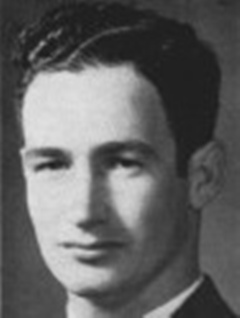DICKINSON-CLARENCE
CLARENCE EARLE DICKINSON JR.

RADM

SHOT DOWN BY JAPANESE PLANES
PEARL HARBOR – 12/7/1941
LT Clarence Earle Dickinson Jr. was assigned as the Flight Officer, the third in command of Scouting Squadron Six (VS-6). On December 7, 1941, he piloted SBD Dauntless dive bomber, BUNO 4570 6-S-4, from USS Enterprise bound for Ford Island to await the ship’s anticipated arrival later that day. He was accompanied by SBD 6-S-9 as his wingman. On reaching Oahu, they unexpectedly found themselves in the midst of numerous Japanese planes attacking Pearl Harbor. Dickinson was shot down during the battle and although he successfully parachuted from his plane, his rear seat radioman/gunner, RM1 William Cicero Miller, died. The following are excerpts from the Action Report dated December 12, 1941, submitted by LT Dickinson concerning the incident.
“At 0825, I was approaching Barbers Point from the south when I noticed numerous shell splashes in the water by the entrance to Pearl Harbor. Upon looking upwards, I saw numerous anti-aircraft bursts above Pearl Harbor. Ewa Field was on fire sending up dense smoke. Smoke was rising from what turned out to be the USS ARIZONA. This covered the channel area and I had seen no other planes. I called 6-S-9 alongside and started climbing. At 4000 feet we leveled off over Barbers Point. Very shortly we were attacked by two Japanese fighters as we headed towards Pearl Harbor. The enemy planes apparently concentrated on 6-S-9. As we went down to 1000 feet the enemy planes were joined by about four others. At that time 6-S-9 caught on fire. It lost speed and dropped about 50 yards astern. I could see it still attempting to fight. I lost sight of it but in a few seconds noticed it below me just as it struck the ground.”
“During this time, my plane was under fire from 3 - 5 enemy planes. My gunner reported that he had been hit followed by a report that he had hit an enemy plane. He then stated that all of his ammunition was expended and that he had been hit again. I looked aft and saw a Japanese plane on fire slowly losing speed and altitude but did not actually see him strike the ground. I was able to get in two short bursts from my fixed guns as one enemy aircraft pulled ahead.”
“My left tank being on fire and my controls being shot away, I told the gunner to jump. The plane went into a right spin at about 1000 feet altitude. When it started to spin, I made the necessary preparations and jumped. I landed unhurt in the vicinity of Ewa Field.”
/s/ C. E. DICKINSON Jr., LT, USN
Following the above ordeal, LT Dickson made his way to Ford Island where he was immediately assigned to participate in an aerial search at sea, his ordeal that morning not having been reported to his superiors. He was awarded the Navy Cross for his performance that day, the first of three Navy Cross Medals he received. His second Navy Cross was received for sinking a Japanese submarine in a bombing attack on December 10, 1942. He continued his service in the Navy until he retired with the rank of Rear Admiral. He died on October 4, 1984, and is buried at the National Memorial Cemetery of the Pacific in Honolulu, Hawaii.
Submitted by CDR Roy A. Mosteller, USNR (Ret)

